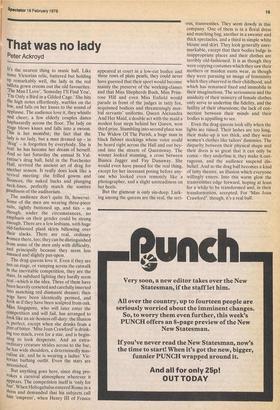That was no lady
Peter Ackroyd
It's the nearest thing to music hall. Like some Victorian relic, battered but holding Up remarkably well, the lady in the red taffeta gown croons out the old favourites: The Man I Love', 'Someday I'll Find You', Pm Only a Bird in a Gilded Cage.' She hits the high notes effortlessly, warbles on the low, and falls on her knees to the sound of applause. The audience love it, they whistle and cheer; a few elderly couples dance haphazardly across the floor. The lady on stage blows kisses and falls into a swoon. This is her moment; the fact that the lady is no lady, but a man dressed up — in 'drag' — is forgotten by everybody. She is real: he has become her dream of herself. And so last Saturday the annual St Valentine's drag ball, held in the Porchester Hall, revived the ancient art of drag for another season. It really does look like a revival meeting: the frilled gowns and flounces, the naked backs and plunging neck-lines, perfectly match the sombre gaudiness of the auditorium.
The audience don't quite fit, however. Some of the men are wearing three-piece suits, tightly buttoned up, and ties — as though, under the circumstances, no emphasis on their gender could be strong enough. There are a few lesbians, with huge Old-fashioned plaid skirts billowing over their slacks. There are real, ordinary Women there, too; they can be distinguished from some of the men only with difficulty, and principaily because they seem less amused and slightly put-upon.
The drag queens love it. Even if they are pot on stage, or vamping across the catwalk in the inevitable competition, they are the stars. In subdued lighting they hardly seem real —which is the idea. Three of them have been heavily corseted and carefully inserted into matching red diamante dresses; their Wigs have been identically permed, and .look as if they have been sculpted from oak. Miss Singapore, who will later enter the competition and will fail, has arranged to look like an air-hostess off-duty: the illusion
IS perfect, except when she drinks from a
Pint of bitter. 'Miss Joan Crawford' is drinking too much, even for a star, and is begin ning to look desperate. And an extra ordinary creature strides across to the bar; he has wide shoulders, a determinedly mas culine air, and he is wearing a ladies' Victorian bathing outfit. Even the stars are astonished.
But anything goes here, since drag provokes a carnival atmosphere wherever it appears. The competition itself is 'only for fun'. When Heliogabalus entered Rome in a dress and demanded that his subjects call him 'empress', when Henry HI of France appeared at court in a low-cut bodice and three rows of plain pearls, they could never have guessed that their sport would become mainly the preserve of the working-classes and that Miss Shepherds Bush, Miss Primrose Hill and even Miss Enfield would parade in front of the judges in tatty fox, sequinned bodices and threateningly morbid servants' uniforms. Queen Alexandra And Her Maid, a double act with the maid a modest four steps behind her Queen, won third prize. Stumbling into second place was The Widow Of The Parish, a huge man in black fishnet stockings whose voice could be heard right across the Hall and out beyond into the streets of Queensway. The winner looked stunning, a cross between Bianca Jagger and Fay Dunaway. She would even have passed for the real thing, except for her incessant posing before anyone who looked even remotely like a photographer, and a slight unsteadiness on her heels.
But the glamour is only sin-deep. Lurking among the queens are the real, the seri
.ous, transvestites. They seem dowdy in this company. One of them is in a floral dress and matching bag, another in a sweater and thick spectacles, and a third in simple white blouse and skirt. They look generally unremarkable, except that their bodies bulge in • inappropriate places and their clothes are terribly old-fashioned. It is as though they were copying costumes which they saw their mothers or maiden aunts wear, as though they were pursuing an image of femininity which they observed in their childhood, and which has remained fixed and immobile in their imaginations. The seriousness and the assiduity of their mimicry of female clothes only serve to underline the fidelity, and the futility of their obsessions; the lack of connection between their minds and their bodies is appalling to see.
Even the drag queens look silly when the lights are raised. Their lashes are too long, their make-up is too thick, and they wear women's clothes like tailors' dummies. The disparity between their physical shape and their dress is so great that it can only be comic — they underline it, they make it outrageous, and the audience suspend disbelief. And so the drag ball becomes a kind of tatty theatre, an illusion which everyone willingly enters. Into this warm glow the transve`stites edge forward, hoping at least for a while to be transformed and, in their transformation, accepted. For 'Miss Joan Crawford'. 'though, it's a real ball'.


































 Previous page
Previous page